
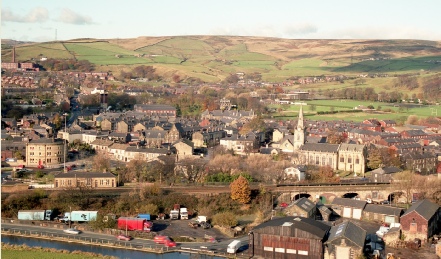
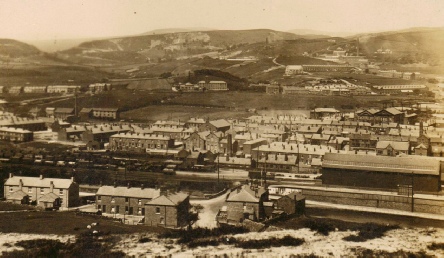
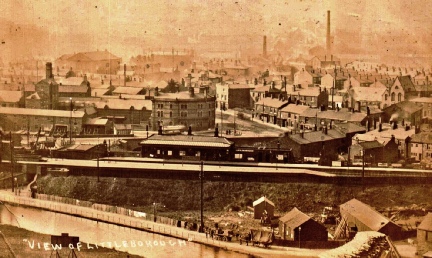
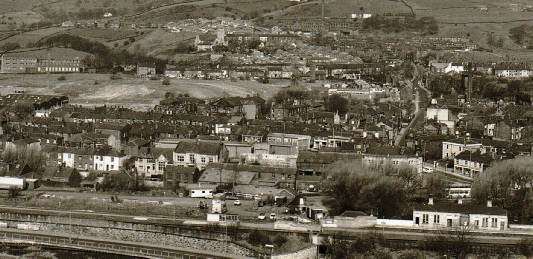


NON-CONFORMIST SCHOOLS – 1851 National Educational Census - 80% Littleborough pupils went to chapel schools as against 50% Nationally
Temple School (see here)
The first mention was in 1839 when Temple Methodist Chapel included a school presumably mainly directed towards Religious education. In 1872 the Old Temple chapel started to be used as school but didn’t become a day school until 1890. Like Mount Gilead it was absorbed by the School Board in Summer 1894 – see Summit School. The building remained for some time before being demolished and replaced by a house.
Smithy Bridge (pictured after services reverted to the first chapel)
Smithy Bridge Methodists opened a school in the top storey of a 3 storey loom house on Smithy Bridge Rd in October 1985. After 1866 they used the Old chapel as Sunday and Day School and this continued for some years until plans were approved for a school extension in February 1876. The enlarged school had 190 scholars in 1890. It continued in use after the Littleborough School Board (LSB) was set up in 1894 but it was acquired by the LSB in the Board’s 2nd term – see later Smithy Bridge Board School. The ‘Methodist’ school building was condemned and the new Board school built but ironically, the ‘condemned’ school building was not demolished and indeed remains as the Methodist Chapel, the replacement chapel having itself been demolished
Mount Gilead School Calderbrook (see here)
This school opened in 1867 as a Sunday School but acted as a Day School as well. It was adjacent to the chapel and located across the road from Smithy Nook cottages. Between 1871 and 1894 the school completed a log book which itemises the ups and downs of school life in the later years of the 19th Century including the matter of pupils attending work and school. The last entry reads “January 5th 1894 School permanently closed as managers cannot see their way to make all of the alterations required by the Education Department”. At the of 1893, 6 months before the LSB was inaugurated the students transferred to St James School making total of 130 pupils of which 64 were in the infants class On closure, the date stone was preserved and in 2011 built into the entrance path supporting wall at the History Centre.
Dearnley Methodist (pictured from before new chapel built)
In the mid 1860’s a group from the Stubley Primitive Methodist formed a separate group in Dearnley and later opened a single chapel cum Sunday School building in September 1868. This building continued in joint use for divine services and Sunday school until 1900 when their new chapel came into use. Thereafter, the ‘old’ chapel continued as a Sunday school. When the “Old” chapel became the Sunday school the windows between the two chapels were made to open so that additional accommodation for a larger congregation could be provided on special occasions. Both buildings remain being well used by members and the local community.
Church St Methodist School – later Peels St. (Pictured right)
Church St Methodist (Sunday) School opened in 1859 with milk costing 2d per quarter and from 1866 the old chapel was used as a school. In 1869 Church St Sunday School opened as a day school with Mr J Kennard as Headmaster. In October 1873 United Methodists opened a new school on Peel St with the old school becoming the Manse. The school on Peel St accommodated 700 pupils and the building included a hall, 5 classrooms on ground and 11 on first floor. Ten years later, the school on Peel St was extended to include an extra 180 children. In 1887 the Peel St school had 501 day students.
Wesleyan School on Victoria St
Plans for a new combined chapel and school were approved in May 1873 with the foundation stones laid on Whit Friday. The new building opened in March 1874 at cost of £2,500. However, in May 1877 plans were approved for a new Church School in Victoria St with the foundation stone laid in July. In 1879 the school opened with space for 250 pupils.
Peel Street and Victoria Street Schools - see here
During January 1879, the United Methodist on Peel Street and Wesleyan Methodist school on Victoria St came the under control of Littleborough Wesleyan Methodist Society. After some 15 years, (In 1893/4) the managers of the Peel street/Victoria Street schools acknowledged that they were unable to meet the increasingly higher standards demanded by the Education Department. This re-invigorated the need for a School Board which duly set up in Summer 1894. This took control of both buildings. In 1897 Peel St and Victoria Street Methodist Schools had around 331 & 348 pupils respectively. These schools were kept going with increasing difficulties until the new Central School was opened in 1903.
Featherstall Methodist Chapel and School
Their chapel opened in 1888 when they took over a small cottage . In 1910 the old cottage was demolished and replaced by a new 2 storey building. It isn’t clear when the chapel closed for worship but references to the school continue to the mid-1940s but that date is the date of last on-line newspaper references. In the 1970s the building was used by the Labour Club, in 1975 by a Hosiery business and is now a hairdressers.
Stubley Primitive Methodist Chapel School
Their chapel opened in 1855 and they also had a Sunday School which most years held an Anniversary event in May to celebrate the founding of the movement. After a struggle with declining congregations the chapel closed in 1979. It is possible the Sunday School closed even earlier.
Featherstall Unitarian School
Dissatisfied with the education provided at Stubley, the Unitarians set up their own school in a building which used to be a warehouse in December 1869. In a report in the RO for 22nd October 1870 it was reported that they had 24 male and female teachers and 44 pupils.
Greenhill Sunday School (pictured right)
In the early 1920’s it became apparent that the chapel was not sufficient to hold religious services and Sunday schools and that an extension would be required. In 1928 the corner stones were laid by Sir Alfred Law JP, Honresfeld, Littleborough (first stone) followed by Mr.W A Kershaw, Littleborough. The new Sunday school would accommodate 250 scholars at a cost of £2,495. The building included a large assembly hall with raised platform at one end, four classrooms, two on either side of the hall
Ebenezer Chapel, Summit
Schoolroom built above two cottages for Ebenezer Chapel circa 1838 – 1842 new school built in 1886. The 1925 Anniversary Booklet refers to their Sunday School which at the time had 55 pupils. When the school finally closed is unclear but Kent’s Rochdale Trade Directory includes the school.
Victoria Street Congregational Chapel and School,
This was opened in April 1869 in a 2 storey building but is likely to have been for religious education on Sundays.
Durn Baptist Church
The first sod was cut for the new School and basement in stone for a ‘Tin’ Chapel built on top. The school included 3 classrooms but there is no information other than to suggest it was mainly a Sunday School. The Tin Church rapidly deteriorated but it wasn’t until February 1886 the Tin Chapel was replaced by Stone. The Chapel closed in 1960
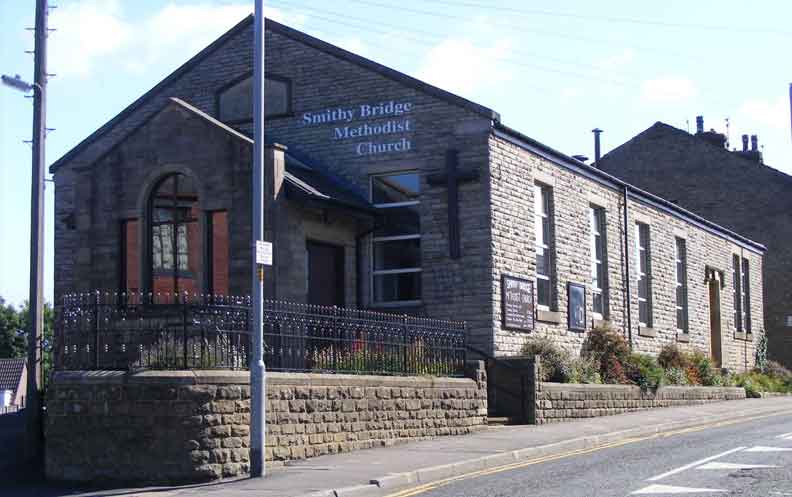
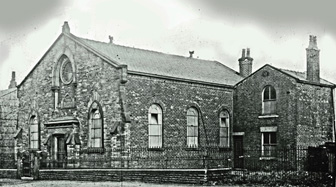
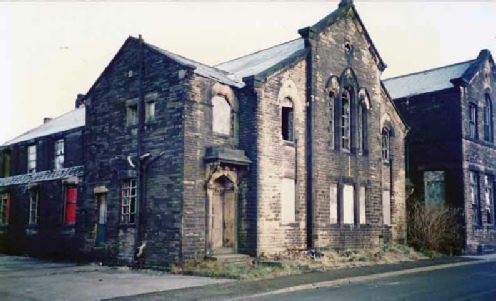
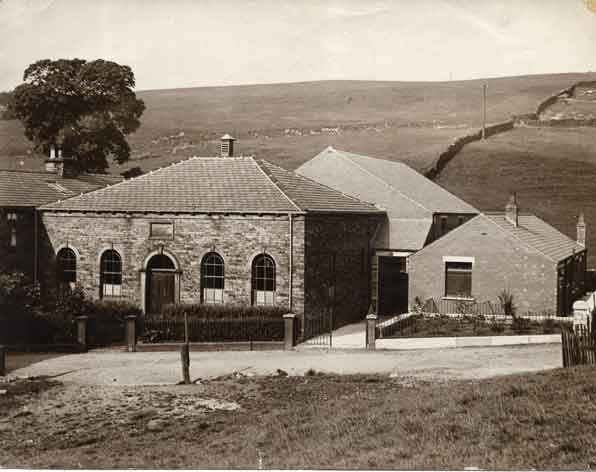
TOP
TOP
TOP
TOP
| Contact Us |
| Rechabites |
| Early Schools |
| Non-conformist schools |
| C of E and RC Schools |
| Board and Local Authority Schools |
| Richard Jay - Coach Operator |
| William Burrill |
| Richard Jay Haukier |
| Leach - Cycles to Haulage |
| H M Sutcliffe |
| J Grindrod & Son Ltd |
| R Rudge and Son Ltd |
| Canal Restoration |
| Clegg Hall & Smithy Bridge |
| Railways in Littleborough Centre |
| Littleborough Viaduct to Summit Tunnel |
| Summit Tunnel |
| Industrial Railways |
| Blackstone Edge Turnpike |
| Calderbrook Turnpike |
| Doghill to Steanor Bottom Turnpike |
| Todmorden Rd TP |
| Toll Roads |
| Industrial Histories |
| History Trails |
| Littleborough Book |
| Pubs & Inns |
| Co-op - Early Grpwth |
| Coop - Central Premises & Competition |
| Coop in 20th Century |
| Coop Decline & Change |
| LANCTAN |
| Schofield Iron Woks |
| Phoenix Iron Works |
| Clegg's Shore Mills |
| Consterdine textile Mills |
| Schofield Textile Mills |
| Rayon (Artificial Silk( Manufacture |
| Mills |
| Deanhead Chemical Works |
| Akzo Chemical Works |
| Starring Pottery |
| Summit Brickworks |
| Tetlows Pottery |
| Whittaker Pottery |
| Coal Mining Map |
| Starring Clay and Coal Mine |
| Cleggswood Colliery |
| Mining around Hollingworth |
| Shackleton - Coal Merchant |
| Possible Roman Littleborough |
| Blackstone Edge Roman Road |
| Roll of Honour |
| WW2 Heroes |